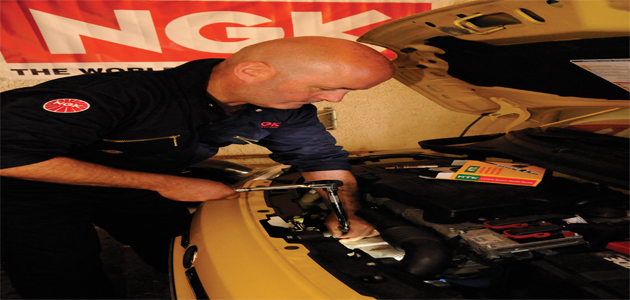
This type of sensor is known as a metal oxide sensor. Unlike zirconium dioxide Lambda sensors,titanium dioxide sensors do not self-generate a voltage. The ceramic element is a semi-conductor, the electrical resistance of which varies relative to the residual oxygen concentration in the exhaust gas. Therefore by application of a voltage to the sensor, a varying signal is produced dependent on the oxygen concentration.
All titanium dioxide Lambda sensors have an integral heating element. By virtue of their design, they do not require access to ambient air for reference. As a result, they are usually more compact than zirconium dioxide types.
The control system for this type is very different to that used for the zirconium dioxide type.
 Method of operation
Method of operation
A titanium dioxide element changes its electrical resistance in proportion to the partial oxygen pressure (in effect, the oxygen concentration) in the gas mixture.
With a high oxygen concentration (Lambda greater than 1.0) the titanium dioxide is less conductive; with a low oxygen concentration (Lambda less than 1.0) it is more conductive.
If a voltage is now applied to the element, the output voltage changes according to the oxygen concentration in the exhaust. The ideal operating temperature of this Lambda sensor is 700˚C as temperatures above 850˚C can damage the sensor element.
Additional advantage
The titanium dioxide sensor does not require any outside air as a reference and is therefore smaller.
Cable assignment
Titanium dioxide Lambda sensors produced by NTK have either three or four cables.
In the four cable types the (+) signal is yellow and the (-) signal is black.
The colour of the cable for the heating element (+) has two variations: for type 1 Lambda sensors this cable is red and for type 2 it is grey. The heating element (-) is white for both. In three wire types the yellow signal (+) cable is omitted. The full cable assignment is shown below.
Type 1 Type 2
Red = Heater (+) Grey = Heater (+)
White = Heater (-) White = Heater (-)
Black = Signal (-) Black = Signal (-)
Yellow = Signal (+) Yellow = Signal (+)
Although far less common than the zirconium dioxide sensor, this type of sensor has been used by many VMs including Alfa Romeo, BMW, Jaguar, Land Rover, Nissan, Vauxhall and Volvo. Due to the profound differences in operating strategy when carrying out diagnostic work it is extremely important that one correctly identifies which type of sensor is fitted to the vehicle. A nice clue is that titanium dioxide sensors have either three or four wires and if they include red or yellow insulators then it is very likely to be of the titanium variety.
TESTING TIPS: One other point to remember is that as this type of sensor functions by varying its electrical resistance, the input voltage will dictate output values. This is important to consider as different VMs have used varying control strategies and although many have an input value of ≈5 volts, some vehicles operate with input values of 1 volt, 3 volts or 5 volts. This means that the switching values range from 0-1 volt, 0-3 v or 0-5 v, again depending on the specific VM’s strategy. When testing sensors – apart from looking at switching frequency and amplitude – it is extremely important to check the integrity of the heater circuit which can be done quite easily using an ohmmeter.









